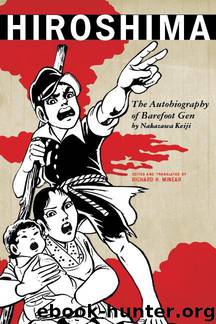Nakazawa Keiji & Richard Minear by Hiroshima: The Autobiography of Barefoot Gen

Author:Hiroshima: The Autobiography of Barefoot Gen
Language: eng
Format: mobi, epub
Tags: Atomic Bomb Victims, Hiroshima-Shi (Japan) - History - Bombardment, Comic Books, 1945, Keiji - Childhood and Youth, Strips, Nakazawa, Etc., Cartoonists, Keiji - Family, Hiroshima-Shi, Etc - Japan - History, Etc, Cartooning, History, Keiji, Art, Hiroshima-Shi (Japan), Cartoonists - Japan, Biography & Autobiography, Japan, Atomic Bomb Victims - Japan - Hiroshima-Shi, Biography, Techniques
ISBN: 9781442207479
Publisher: Rowman & Littlefield
Published: 1994-01-02T06:00:00+00:00
TWO-FISTED CHAMP
Having found work, Uncle Y. came for the son he’d left in our care, and our household shrank to four. Tomoko had died, and I was forlorn; I had lost all I had to live for. It was hard for me to walk past a woman with a baby on her back. It was tough when I caught the lingering sweet smell of mother’s milk and memories came back of the days when I warmed my back carrying Tomoko and fed her the thick soup.
At the time, the wood and boards that we scavenged busily at night from the collapsed Army barracks piled up, and our hopes of building a hut materialized. We asked a carpenter acquaintance of Mom’s to build it in the burned-out waste of Takajo¯-machi, where Uncle H. lived. Loading the wood onto a large cart, we hauled it laboriously through the ruins. Our hearts leapt as we watched our house go up. We savored our joy at escaping Eba, the town where we had nothing but bitter, sad, and hateful memories. The only thing I’d learned at Eba’s elementary school was the multiplication tables.
Erected in the burned-out ruins of Takajo¯, our house didn’t have sliding rain doors or sliding screens. We separated the rooms and kept the wind from blowing through by hanging mats made of straw. It was a crude hut, but we were absolutely delighted to call it home. In the candlelight on the night we moved in, the faces of Mom and Ko¯ji and Akira were flushed with excitement.
Our house looked out over a vast sweep of ruins. At night, lanterns were alight in the scattered shacks; it was just as if fireflies were out. When night deepened and we lay on the blankets, straining our ears, it seemed we could hear the pulse of the reviving Hiroshima. There was nothing in the burned-out waste to block sound, so the horns of ships leaving Ujina Harbor off in the distance boomed as if they were nearby. We drank in the sound: “Wonder where that ship is going—abroad?” From the yards of Hiroshima Station came the sound of freight cars coupling; engines blew their steam whistles—Choo! Choo!—and left the station. “Wonder what that freight train’s carrying?” The night train went through—clickety-clack—on the main east-west line. We pictured it to ourselves: “Wonder who’s on the night train? Maybe it’s full of repatriated soldiers. It’s going to Osaka and Tokyo. Osaka and Tokyo: wonder what shape they’re in.” Winter pilgrimages began, with ascetics dressed in white, rosaries around their necks, beating fan-shaped drums—tap, tap, tap—and the sound of feet tramping through the burned-out waste. Night after night we fell asleep with a sense of security because human beings were out there and we had the feeling that Hiroshima was reviving at a good pace.
Akira and I tilled the burned-out waste and worked hard preparing a field for planting. When we removed tiles and turned the soil over, skulls emerged. In the field we planted all sorts of edibles according to the season and worked early and late to produce food.
Download
Nakazawa Keiji & Richard Minear by Hiroshima: The Autobiography of Barefoot Gen.epub
This site does not store any files on its server. We only index and link to content provided by other sites. Please contact the content providers to delete copyright contents if any and email us, we'll remove relevant links or contents immediately.
| Africa | Americas |
| Arctic & Antarctica | Asia |
| Australia & Oceania | Europe |
| Middle East | Russia |
| United States | World |
| Ancient Civilizations | Military |
| Historical Study & Educational Resources |
The Sympathizer by Viet Thanh Nguyen(4305)
The Rape of Nanking by Iris Chang(4138)
World without end by Ken Follett(3429)
Ants Among Elephants by Sujatha Gidla(3417)
Blood and Sand by Alex Von Tunzelmann(3138)
Japanese Design by Patricia J. Graham(3110)
City of Djinns: a year in Delhi by William Dalrymple(2514)
The Queen of Nothing by Holly Black(2498)
Foreign Devils on the Silk Road: The Search for the Lost Treasures of Central Asia by Peter Hopkirk(2434)
India's Ancient Past by R.S. Sharma(2416)
Inglorious Empire by Shashi Tharoor(2395)
Tokyo by Rob Goss(2389)
In Order to Live: A North Korean Girl's Journey to Freedom by Yeonmi Park(2346)
India's biggest cover-up by Dhar Anuj(2318)
Tokyo Geek's Guide: Manga, Anime, Gaming, Cosplay, Toys, Idols & More - The Ultimate Guide to Japan's Otaku Culture by Simone Gianni(2315)
The Great Game: On Secret Service in High Asia by Peter Hopkirk(2305)
Goodbye Madame Butterfly(2203)
Batik by Rudolf Smend(2124)
Living Silence in Burma by Christina Fink(2038)
